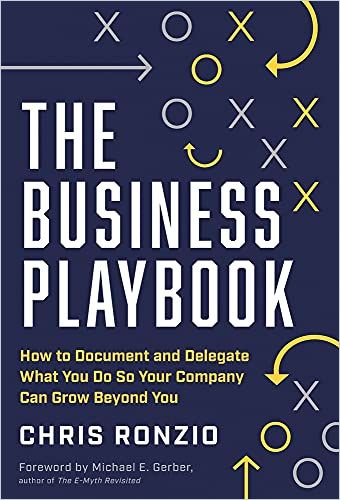Podcast host Chris Ronzio details how to construct, maintain, and update a company playbook for consistent, efficient operations.

Explaining Yourself Is Good Business
Every business must communicate its identity, how it works, and who does what. Particularly in smaller businesses, it makes sense to develop a playbook to guide new hires and old hands. Chris Ronzio — host of The Fastest Growing Companies and Organize Chaos podcasts — explains how you will benefit from documenting everything about your company’s day-to-day functions.
Step-by-step directions
Owners, entrepreneurs, and executives who control the day-to-day workings of a company benefit most from having a playbook.A strong playbook brings order out of chaos by enabling everyone involved to understand an organization’s operations and delegate efficiently.
A playbook sets guidelines that enable new hires to understand what to expect and supports seasoned team members when they mentor new hires. When pivotal employees need to be absent, a playbook helps them choose who can step in. Make sure your playbook is easily available within your organization, ideally online.
The real problem is that you keep your business, and everything about how it runs, locked up inside your head.Chris Ronzio
Ronzio emphasizes that a successful playbook aligns the entire team with the firm’s vision and core values. Meld the playbook concept into your firm’s DNA. Make sure your staff understands the purpose of your playbook and how it affects them.
The Purpose of Your Playbook
Every playbook should begin with a business profile that explains the company, its history, core values, goals, and distinctive traits.
The playbook explains how the company operates and what it expects from its staff members in terms of hours, attire, conduct, and adherence to corporate policy. Organize your playbook in clear sections so the structure is sensible and comprehensible. Use a flowchart to help people understand how their work fits into the bigger picture.
As you prioritize what to include in your playbook, determine which tasks everyone needs to know and which tasks the largest number of employees repeat most frequently. Having more staff people engaged in any activity means greater opportunities for deviation, so, to ensure consistent service, your playbook must include detailed expectations.
Like any strategic goal, the playbook needs a champion — someone to keep it SMART (specific, measurable, attainable, relevant, and time-based).Chris Ronzio
Ronzio warns against turning your playbook into a checklist. Rather than just itemizing various steps, discuss the reasons behind each step to empower your employees to act. Be sure your playbook is adaptable and user-friendly. Monitor its progress and stay on top of the team putting it together. Keep it up-to-date with regular and timely reviews and revisions.
Company Profile
Provide a corporate profile to tell new employees what to expect and acquaint investors and others with the firm. Begin with a welcome message. Tell the story of the company’s history; if you’re the founder, tell the story of how you founded your firm.
State your vision of what you hope the business will accomplish. Your vision and mission are the face your business presents to the world. Use your playbook to enunciate the values that should guide your employees.
Table of Contents
Ronzio suggests creating five to 20 playbook chapters or “collections” that correspond to your firm’s different bailiwicks and branches. These sections might include, for example, “HR, Customer Support, Finance and Accounting, Marketing, Sales, IT, and “Operations.” Each process has four hierarchical tiers: “collections,” “subjects,” “topics,” and “steps.”
The process section of your playbook outlines the steps involved in fulfilling your firm’s deliverables. Specify each step necessary to complete a job. Document your most common processes, especially those most people use often. To keep it readable, Ronzio advises using no more than 200 words to cover each process and breaking up the required learning time into no more than 10-minute increments.
Every business needs a playbook. It’s time to create yours.Chris Ronzio
Include a personnel section to help colleagues get to know one another. This gives those with longer tenure a place to recount what they experienced as the organization grew. Consider providing brief team-member bios. Employees can draft their own, including job titles, insights into their tasks, how they think their role contributes to the company, and information about their hobbies or pastimes that present a richer self-portrait. Include contact information and social media links.
Use a section of the playbook to offer a menu of the firm’s products and services with approximate pricing information. If your employees use uncommon or unknown terms that are specific to your business, provide a glossary.
Explain legally mandated standards, regulations, and disclosures. Provide information about benefits and cultural norms such as hours, remote work, dress codes, rules about not dating colleagues, and the like.
State your organization’s policies clearly. Adapt those policies as the business changes. Be aware that the policies each employee follows may vary depending on that person’s location and role. Clarity, concision, practicality, and evenhandedness should govern the policy section.
Alarm Bells
Employees may resist sharing information about their roles.They may hesitate to discuss something they know or do exclusively, particularly if they think it gives them unique value. Ronzio warns that asking employees how they perform certain functions can set off their alarm bells about job security. To allay such concerns, inform people about the purpose of the playbook project. Assemble everyone and explain it in person, distribute an information sheet, or offer a video or slide presentation. Individualize your outreach to engage and motivate each staff member.
Some seasoned employees may take what they do for granted or may follow a complex routine that they find difficult to explain. Draw them out by having someone who isn’t familiar with their job ask questions or record them at work.
Heed employee feedback. When you expand departments or shift responsibilities, share best practices to streamline any transition. Explain why doing pivotal tasks a certain way matters, whether at the corporate, managerial, or employee level.
A Clear Manual
Chris Ronzio details how to create a business playbook and how to put it to good use. In simple, clear language, he provides a manual listing every aspect and every chapter an effective, efficient playbook must contain. Ronzio breaks down each section into subsections; you could easily construct your playbook page by page by following his advice. Businesspeople seeking to keep their companies running smoothly – especially when they are not present – will benefit from Ronzio’s system.









